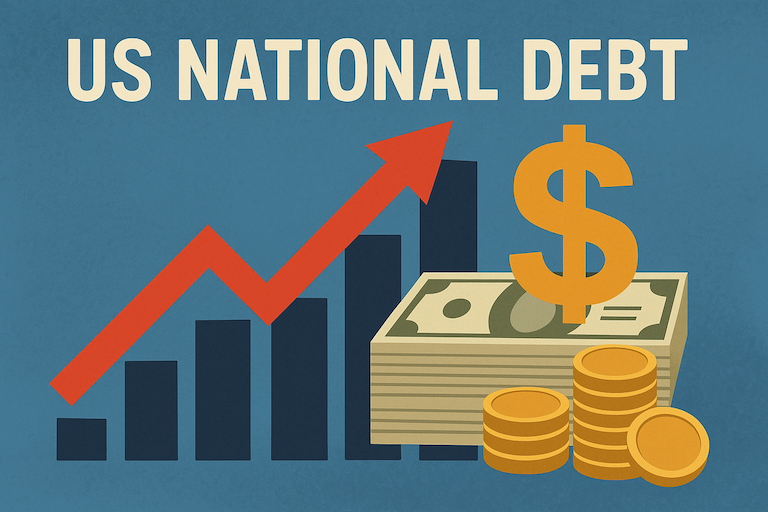The U.S. national debt has hit record levels, sparking debate over its causes, consequences, and potential solutions. As of 2025, the federal debt stands at a staggering $36.56 trillion. In this post, we’ll break down how the debt reached this point, examine the role of the Department of Government Efficiency (DOGE) in tackling it, and explore what the future may hold.
How Did the U.S. Debt Get So High?
The national debt didn’t balloon overnight. It has been growing for decades due to a mix of military spending, tax cuts, economic crises, and government programs. Here’s a quick timeline of major contributing factors:
- 1980s: Military expansion and tax cuts under President Reagan tripled the debt. (Source)
- 2000s: Wars in Iraq and Afghanistan, along with tax cuts, increased federal borrowing. (Source)
- 2008 Financial Crisis: The government bailed out banks and launched stimulus programs. (Source)
- 2020 COVID-19 Pandemic: Massive relief packages were passed to prevent economic collapse. (Source)
- Ongoing Factors: An aging population, rising healthcare costs, and interest payments continue to add to the debt. (Source)
The DOGE Initiative: Can It Reduce the Debt?
In response to rising debt concerns, President Trump launched the Department of Government Efficiency (DOGE) in 2025, appointing Elon Musk to lead the charge in cutting federal spending. The goal? To slash $1 trillion in wasteful spending within 130 days.
DOGE’s Key Actions:
- Privatizing the U.S. Postal Service: Aimed at reducing government expenses and increasing efficiency. (Source)
- Restructuring the Department of Defense: Cutting redundant programs while maintaining national security. (Source)
- Cracking Down on Social Security Fraud: Tightening enforcement to prevent fraud and unnecessary payouts. (Source)
While DOGE has made bold moves, critics argue that many of its projected savings—such as canceling federal contracts—haven’t fully materialized. Investigations have revealed that some of the contracts DOGE claimed to cut were still active, raising doubts about the effectiveness of the initiative. (Source)
What’s Next for U.S. Debt?
Regardless of DOGE’s success or failure, certain economic realities will shape the national debt in the coming years:
- Rising Interest Payments: The cost of servicing the debt is now higher than defense and housing expenditures combined. (Source)
- Exponential Increase in Debt: Even if no new spending is introduced, the debt is expected to grow rapidly due to interest compounding. Higher debt leads to higher interest payments, which in turn require more borrowing, creating a dangerous cycle. (Source)
- Inflation as a Strategy: Some economists argue that inflation could reduce the real value of the debt, though it risks triggering a recession. (Source)
- Long-Term Fiscal Reforms: To truly tackle debt, policymakers must address entitlement spending, tax policy, and economic growth strategies. (Source)
Lessons from Other Countries
Several countries have successfully reduced their national debt through strategic reforms. Here are a few examples:
- Canada (1990s): Faced with rising debt, Canada implemented aggressive spending cuts and tax reforms, turning deficits into surpluses within a decade. (Source)
- Germany (2010s): Through strict fiscal discipline and economic growth policies, Germany reduced its debt-to-GDP ratio significantly after the European debt crisis. (Source)
- Sweden (1990s): Sweden combined tax hikes and spending cuts to overcome a financial crisis, creating long-term fiscal stability. (Source)
- New Zealand (1980s-90s): By privatizing state-owned enterprises and reducing government spending, New Zealand dramatically lowered its debt burden. (Source)
Possible Solutions to Fix the Debt Crisis
Addressing the debt crisis requires a combination of approaches, including:
- Spending Cuts: Reducing non-essential government spending without compromising critical services.
- Tax Reforms: Closing loopholes, adjusting tax rates, and ensuring fair tax collection.
- Economic Growth Strategies: Encouraging business expansion, increasing workforce participation, and boosting innovation.
- Debt Restructuring: Renegotiating debt terms to reduce long-term interest costs.
- Public-Private Partnerships: Leveraging private sector investments to fund infrastructure and essential services.
- Bitcoin Strategic Reserve: Some policymakers have proposed the idea of accumulating Bitcoin as a strategic reserve asset. The argument is that, as a decentralized and deflationary currency, Bitcoin could hedge against inflation and provide an alternative store of value. If the U.S. were to allocate a portion of its reserves into Bitcoin, proponents believe it could enhance fiscal stability, attract investment, and reduce reliance on traditional monetary expansion tactics. (Source)
How to Protect Yourself from Economic Uncertainty
With the national debt climbing, individuals should take steps to safeguard their financial future:
- Diversify Investments: Spread investments across stocks, bonds, real estate, and commodities like gold to hedge against inflation.
- Build an Emergency Fund: Have savings to cover 6-12 months of expenses in case of economic downturns.
- Reduce Personal Debt: Avoid excessive borrowing and focus on paying down high-interest loans.
- Stay Informed: Follow economic trends and adjust financial strategies accordingly. (Source)
- Consider Inflation-Proof Assets: Investing in assets like real estate, inflation-protected securities, or commodities can help maintain purchasing power. (Source)
FAQ: Common Questions About U.S. Debt
What happens if the U.S. doesn’t reduce its debt?
If the debt continues to rise unchecked, it could lead to higher interest rates, slower economic growth, and reduced government spending on essential services. (Source)
Can the U.S. go bankrupt?
Technically, no. The U.S. controls its currency and can always print more money, but doing so recklessly could trigger inflation or weaken global confidence in the dollar. (Source)
How does national debt impact everyday Americans?
Higher debt can lead to higher taxes, reduced government benefits, and slower economic growth, affecting wages and job opportunities. (Source)
End Game
The U.S. national debt is a complex issue with no easy solutions. While initiatives like DOGE aim to rein in spending, the long-term answer lies in strategic reforms and economic growth. Learning from other countries’ successes in managing debt may offer valuable insights. However, with interest payments growing exponentially, the problem could soon become even harder to manage. Whether the government takes aggressive action or lets the debt continue rising, one thing is clear—this issue isn’t going away anytime soon.

Leave a Reply